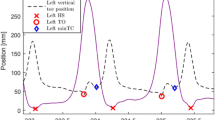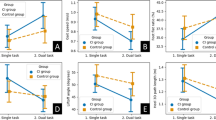Abstract
Background and aims: Increased gait variability is associated with a high risk of falling in older community-dwellers, but no information exists about the relationship between increased gait variability and falls occurring in older hospitalized patients. We therefore sought to determine, in an acute geriatric setting, whether gait variability in single- (i.e., usual walking) or dual-task conditions can predict inpatient falls. Methods: Stride time variability was calculated in both single-task (i.e., usual walking) and dual-task conditions with a GAITRite®-System in 13 male and 44 female patients (mean age=85.0, SD=6.6 yrs) consecutively admitted to the acute care geriatric department of Geneva University Hospitals, Switzerland. All participants were able to walk without assistive devices at day 3 post-admission. Falls during hospital stay were identified through the hospital accident reporting system. Results: Ten fallers and 47 non-fallers were identified. The first fall events were significantly associated with the coefficient of variation of stride time in both walking conditions during hospital stay (OR 13.3, (95% CI 1.6–113.6), p=0.018 for usual walking; OR 8.6, (95% CI 1.9–39.6), p=0.006 for dual-task walking). Furthermore, the time elapsing between the first day of hospitalization and the first fall was significantly shorter when the cut-off value of stride time variability was calculated for dual-tasking compared with usual walking. The Cox regression model revealed that only the coefficient of variation of stride time during dual-task walking was significantly associated with the occurrence of the first fall event (p=0.006). Conclusion: Our results suggest that the degree of stride time variability in dual-task walking conditions distinguished fallers from non-fallers in a group of independently walking, older inpatients.
Similar content being viewed by others
References
Bates D, Pruess K, Souney P, Platt R. Serious falls in hospitalized patients; correlates and resource utilization. Am J Med 1995; 99: 137–43.
Vassallo M, Vignaraja R, Sharma JC, Briggs R, Allen S. The relationship of falls to injury among hospital in-patients. Int J Clin Pract 2005; 59: 17–20.
Vassallo M, Sharma JC, Allen SC. Characteristics of single fallers and recurrent fallers among hospital in-patients. Gerontology 2002; 48: 147–50.
Oliver D. Bed falls and bedrails-what should we do? Age Ageing 2002; 31: 415–8.
Oliver D, Hopper A, Seed P. Do hospital fall prevention programs work? A systematic review. J Am Geriatr Soc 2000; 48: 1679–89.
Oliver D, Daly F, Martin FC, McMurdo ME. Risk factors and risk assessment tools for falls in hospital inpatients: a systematic review. Age Ageing 2004; 33: 122–130.
Bloem BR, Steijns JA, Smits-Engelsman BC. An update on falls. Curr Opin Neurol 2003; 16: 15–26
Bloem BR, Valkenburg VV, Slabbekoorn M, Willemsen MD. The Multiple Tasks Test: development and normal strategies. Gait Posture 2001; 14: 191–202.
Lundin-Olsson L, Nyberg L, Gustafson Y. “Stops walking when talking” as a predictor of falls in elderly people. Lancet 1997; 349: 617.
Lundin-Olsson L, Nyberg L, Gustafson Y. Attention, frailty, and falls: the effect of a manual task on basic mobility. J Am Geriatr Soc 1998; 46: 758–61.
Verghese J, Buschke H, Viola L, et al. Validity of divided attention tasks in predicting falls in older individuals: a preliminary study. J Am Geriatr Soc 2002; 50: 1572–6.
Stalenhoef PA, Diederiks JP, Knottnerus JA, Kester AD, Crebolder HF. A risk model for the prediction of recurrent falls in community-dwelling elderly: a prospective cohort study. J Clin Epidemiol 2002; 55: 1088–94.
Bootsma-van der Wiel A, Gussekloo J, de Craen AJ, van Exel E, Bloem BR, Westendorp RG. Walking and talking as predictors of falls in the general population: The Leiden 85-Plus Study. J Am Geriatr Soc 2003; 51: 1466–71.
Hausdorff JM, Yogev G, Springer S, Simon ES, Giladi N. Walking is more like catching than tapping: gait in the elderly as a complex cognitive task. Exp Brain Res 2005; 164: 541–8.
Sheridan PL, Solomont J, Kowall N, Hausdorff JM. Influence of executive function on locomotor function: divided attention increases gait variability in Alzheimer’s disease. J Am Geriatr Soc 2003; 51: 1633–7.
Coppin AK, Shumway-Cook A, Saczynski JS, et al. Association of executive function and performance of dual-task physical tests among older adults: analyses from the InChianti study. Age Ageing 2006; 35: 619–24.
Maki BE. Gait changes in older adults: predictors of falls or indicators of fear. J Am Geriatr Soc 1997; 45: 313–20.
Hausdorff JM, Rios DA, Edelberg HK. Gait variability and fall risk in community-living older adults: a 1-year prospective study. Arch Phys Med Rehabil 2001; 82: 1050–6.
Alexander NB. Gait disorders in older adults. J Am Geriatr Soc 1996; 44: 434–51.
Bilney B, Morris M, Webster K. Concurrent related validity of the GAITrite® walkway system for quantification of the spatial and temporal parameters of gait. Gait Posture 2003; 17: 68–74.
Beauchet O, Kressig RW, Najafi B, Aminian K, Dubost V, Mourey F. Age-related decline of gait control under a dual-task condition. J Am Geriatr Soc 2003; 51: 1187–8.
Cutlip RG, Mancinelli C, Huber F, DiPasquale J. Evaluation of an instrumented walkway for measurement of kinematic parameters of gait. Gait Posture 2000; 12: 134–8.
Aminian K, Najafi B, Bula C, Leyvraz PF, Robert P. Spatio-temporal parameters of gait measured by an ambulatory system using miniature gyroscopes. J Biomech 2002; 35: 689–99.
Moe-Nilssen R, Helbostad JL. Estimation of gait cycle characteristics by trunk accelerometry. J Biomech 2004; 37: 121–6.
Mayagoitia RE, Nene AV, Veltink PH. Accelerometer and rate gyroscope measurement of kinematics: an inexpensive alternative to optical motion analysis systems. J Biomech 2002; 35: 537–42.
Alexander NB. Using technology-based techniques to assess postural control and gait in older adults. Clin Geriatr Med 1996; 12: 725–44.
Kressig RW, Beauchet O. Guidelines for clinical applications of spatio-temporal gait analysis in older adults. Aging Clin Exp Res 2006; 18: 174–6.
Menz HB, Latt MD, Tiedemann A, Mun San Kwan M, Lord SR. Reliability of the GAITRite system for the quantification of temporo-spatial parameters of gait in young and older people. Gait Posture 2004; 20: 20–5.
McDonough AL, Batavia M, Chen FC, Kwon S, Ziai J. The validity and reliability of the GAITRite system’s measurements: a preliminary evaluation. Arch Phys Med Rehabil 2001; 82: 419–25.
Podsiadlo D, Richardson S. The timed “Up & Go”: a test of basic functional mobility for frail elderly persons. J Am Geriatr Soc 1991; 39: 142–8.
Folstein MF, Folstein SE, McHugh PR. “Mini-mental state”. A practical method for grading the cognitive state of patients for the clinician. J Psychiatr Res 1975; 12: 189–98.
Loew F, Registe-Rameau Y, Kressig R, Marcant D, Herrmann F, Michel JP. Epidemiology of falls in a geriatric ward: rationale for a quality program. In: Michel JP, Hof PR, eds. Management of Aging. The University of Geneva Experience. Basel: Karger, 1999: 44–52.
McMurdo ME, Harper JR. Institutional falls: quality not quantity. Age Ageing 2004; 33: 399–400.
Oliver D. Prevention of falls in hospital inpatients: agendas for research practice. Age Ageing 2004; 33: 328–30.
Beauchet O, Berrut G. Gait and dual-task: definition, interest, and perspectives in the elderly. Psychol Neuropsychiatr Vieil 2006; 4: 215–25.
Nakamura T, Meguro K, Sasaki H. Relationship between falls and stride length variability in senile dementia of the Alzheimer type. Gerontology 1996; 42: 108–13.
Woollacott M, Shumway-Cook A. Attention and the control of posture and gait: a review of an emerging area of research. Gait Posture 2002; 16: 1–14.
Dubost V, Beauchet O, Herrmann F, Kressig RW. Stride-to-stride variability while backward counting among healthy young adults: Transversal study. J Neuroengineering Rehabil 2005; 2: 26.
Author information
Authors and Affiliations
Corresponding author
Rights and permissions
About this article
Cite this article
Kressig, R.W., Herrmann, F.R., Grandjean, R. et al. Gait variability while dual-tasking: fall predictor in older inpatients?. Aging Clin Exp Res 20, 123–130 (2008). https://doi.org/10.1007/BF03324758
Received:
Accepted:
Published:
Issue Date:
DOI: https://doi.org/10.1007/BF03324758




